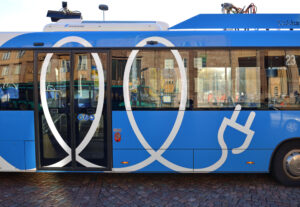Can U.S. Electric Grids Support Electric Buses and Trucks?

At the end of 2014, there were fewer than 1 million electric cars on the road.
But over the next five years, electric vehicle adoption increased by an average of 60% annually. By December 2019, there were 7.2 million electric cars in operation globally.
(Including mine! I own a Tesla and was one of the earliest voices to champion the company’s stock.)
Today, about 40% of all EVs are in China. But Europe and the U.S. are both experiencing rapid EV growth.
The car-buying public is jumping into EVs in a big way. And utilities have been able to handle the increased load to charge them… so far.
There could be a problem brewing for utilities. And many aren’t doing anything proactively to head it off at the pass.
The next focus for EV manufacturers is electric buses (e-buses) and electric semitrucks. They’re the next big disruption coming to the transportation sector.
It’s all very exciting, but let’s look at what’s ahead for the electric grid.
Houston, Do We Have a Problem?
Drivers “refuel” EVs by plugging them into a home charger or a charging station on the road. Regardless of where drivers plug in, the power comes from the electric utility’s grid.
Recharging EVs presents a serious, growing problem for utilities because their grids have design limits.
Any given grid can supply only so much power. If that level is exceeded, wires can overheat. That often causes circuit breakers to trip open. At that point, the utility may have no choice but to shut down the grid or institute rolling blackouts.
(That’s exactly what’s been happening in California as a result of the heat wave and wildfires it’s experiencing.)
Now, interest in e-buses and electric trucks is starting to ramp up. Companies that want to reduce their transportation carbon footprints are placing orders.
But most utilities aren’t planning for the added electricity consumption, which could keep e-buses and electric trucks off the road for a long time.
Fleets of these vehicles would need a lot of power for battery recharging.
For example, a Tesla Model 3 battery has 75 kilowatt-hours (kWh) of capacity. Contrast that with the Proterra Catalyst 40-foot e-bus. It sports a 660-kWh battery. That’s nearly 10 times the size of the Model 3’s battery.
Charging a fleet of e-bus or electric truck batteries similar in size to the Proterra Catalyst’s can have a huge impact on a utility’s load.
For example, the bustling international city of Amsterdam has an e-bus transit fleet of 100 vehicles. These buses serve the city’s busy Schiphol Airport.
They run six different routes around the airport. And they operate 24/7, every day of the year.
The buses’ two main charging bases are each billed as “the world’s largest charging depot.” Together, they have 109 fast-charging stations.
Eighty-six of them can charge at a rate of 30 kilowatts (kW). They are used to charge buses overnight.
The other 23 are super-fast. Used during the day, they can charge at a rate of 450 kW and recharge the buses’ batteries in two to four minutes.
(To connect with the super-fast chargers, the buses are equipped with roof-mounted pantographs, similar to the ones used on electric trains and trolleys.)
 All that charging infrastructure draws 13 megawatts (MW) of power from the local utility. That’s about the same amount of power a large factory uses.
All that charging infrastructure draws 13 megawatts (MW) of power from the local utility. That’s about the same amount of power a large factory uses.
And Amsterdam is thinking of expanding its e-bus fleet to 250. This will mean another huge increase in demand from the local utility.
The Ongoing Evolution of EVs
E-buses are just the beginning. Many companies around the globe are focusing on “last mile” electric trucks and vans.
Amazon has plans to equip each of its fulfillment centers with a fleet of 200 electric vans for last-mile deliveries. Each charging station built to handle them will draw about 4 MW from the local grid.
An electric semitruck charger may require 2 MW of power per truck. All of this additional electricity is more than most utilities can provide on short notice.
In many cases, new infrastructure investment and planning are required. To meet the growing needs of e-buses and electric trucks, utilities must take a proactive stance.
New distribution lines may be needed to handle additional loads. For big installations like Amsterdam’s, new substations may be needed.
The California Electric Transportation Coalition did a study on power requirements for electric truck and e-bus charging stations. It found that loads greater than 5 MW need both substation and distribution line upgrades.
Costs can run $10 million or more per site. When is a good time for utilities to start planning for this?
The answer is simple: NOW.
E-buses and electric trucks are set to experience rapid growth for a decade or more. Investors need to keep an eye on this growing part of the transportation sector.
I’d like to get your feedback on the electrification of our transportation network and to hear from any EV owners out there. Leave your thoughts in the comments using the button below.
Good investing,
Dave






